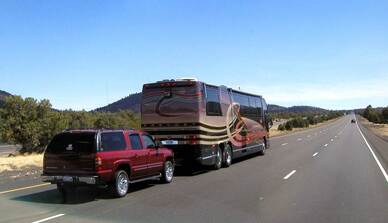Harris, Reed & Seiferth
|
 When traveling in an RV, you may find it helpful to have a vehicle available for a run to the store or a short excursion without having to pack up all your gear and maneuver your rig through crowded city streets. Many experienced RV owners tow a car or truck for the convenience of having a more compact vehicle on hand. Here are the different options for towing and tips on how to do so safely. Four Wheels Down (Toading, Dinghy Towing or Flat Towing) This is the most popular method for towing a vehicle behind an RV, which involves attaching a tow bar and letting your vehicle roll behind the RV on its own four tires. Benefits of this method include minimal, if any, impact on the gas mileage, handling, and wear and tear of your RV; the equipment needed to attach a car by a tow bar is cheaper than purchasing a dolly or flatbed trailer; and you don’t need a separate trailer license. However, there are a few drawbacks. Not all vehicles are equipped to be towed on four wheels so check the owner’s manual, manufacturer’s guidelines and mechanical capabilities of your vehicle before investing in this option. In addition, though this shouldn’t add miles to your car’s odometer, it will cause wear on the car tires. Two Wheels Down (Dolly Towing) For this method of towing, a dolly attaches to the back of your RV and the vehicle rides with two tires up on the dolly and the other two tires down on the road. Any front-wheel-drive vehicle can be towed this way. Plus, you won’t damage your car’s transmission or increase mileage while it’s in motion. The downsides of this method is that a quality dolly trailer is expensive; you may need a separate license for the dolly; it could be difficult to store at a campsite; it puts wear on the two car tires that are down; and it adds weight to the capacity of your RV. If you’re thinking about choosing this option, calculate what the overall weight will be (before purchasing the dolly) to ensure your RV will be able to handle it. Four Wheels Up (Flatbed Trailer) The third option for towing a vehicle is with all wheels up on a flatbed trailer that’s attached to the RV. Any vehicle can go on a flatbed trailer as long as it can be secured and as long as the trailer is built to handle the weight of your specific vehicle. Before purchasing a trailer, decide what vehicle you’re going to bring with when traveling and then compare trailer options based on the amount of weight they can haul. Similar to dolly towing, the drive shaft is off the ground so you won’t rack up mileage. Also, with this method, your tires won’t endure any wear and tear. Disadvantages of four wheels up is you’ll have the extra cost of the trailer; you may run into storage issues at campgrounds; and the weight of a flatbed trailer will use up a lot of the weight your RV can carry. Whichever method you choose, it’s important to take extra precautions when you tow a car behind an RV. Here are some basic safety guidelines to follow:
Source: https://www.foremost.com/learning-center/options-for-towing-a-vehicle-behind-your-rv.asp
0 Comments
Leave a Reply. |
Categories
All
Archives
May 2024
|
Social MediaContact UsNavigation |
|
Website by InsuranceSplash
Privacy Policy | Terms of Use
© 2025 by HARRIS, REED & SEIFERTH INSURANCE GROUP, INC. All rights reserved.
© 2025 by HARRIS, REED & SEIFERTH INSURANCE GROUP, INC. All rights reserved.

 RSS Feed
RSS Feed